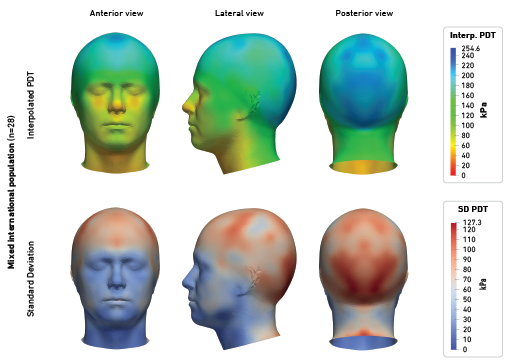When designing wearables that interface with the human head, face and neck, designers and engineers consider human senses, ergonomics and comfort. A dense 3D pressure discomfort threshold map could be helpful in the design process. My colleagues and I recorded differences in pressure discomfort threshold for areas of the head, neck and face, to create a 3D pressure discomfort threshold map.
Method summary
Between 126 and 146 landmarks were placed on the left side of the head, face and neck of twenty-eight healthy participants (gender balanced). The positions of the landmarks were specified using an EEG 10–20 system-based landmark-grid on the head and a self-developed grid on the face and neck. A 3D scan was made to capture the head geometry and landmark coordinates. In a randomised order, pressure was applied on each landmark with a force gauge until the participant indicated experiencing discomfort. By interpolating all collected pressure discomfort thresholds based on their corresponding 3D coordinates, a dense 3D pressure discomfort threshold map was made.
A relatively low-pressure discomfort threshold was found in areas around the nose, neck front, mouth, chin-jaw, cheek and cheekbone, possibly due to the proximate or direct location of nerves, blood veins and soft (muscular) tissue. Medium pressure discomfort was found in the neck back, forehead and temple regions. High pressure discomfort threshold was found in the back of the head and scalp, where skin is relatively thin and closely supported by bone, making these regions interesting for mounting or resting head, face and neck related equipment upon.

FURTHER READING
If you are interested in reading further on this work, please see Smulders, M., van Dijk, L.N.M., Song, Y., Vink, P., & Huysmans, T. (2023). Dense 3D pressure discomfort threshold (PDT) map of the human head, face and neck: A new method for mapping human sensitivity. Applied Ergonomics, 107, 103919. https://doi.org/10.1016/j.apergo.2022.103919 (Open Access).
DATASET
We also have the full dataset available, including easy to use *.obj files to be used as reference models in CAD. The dataset also includes eigenmodes based on the CAESAR database, which can be adjusted to create own eigenmodes with our PDT map (for instructions on how to create them, please see the README.pdf file). Here you can find the dataset Smulders, M., van Dijk, L.N.M., Song, Y., Vink, P., & Huysmans, T. (2022). Dense 3D pressure discomfort threshold (PDT) map of the human head, face and neck [Dataset] (Version 1). 4TU.ResearchData. https://doi.org/10.4121/21482328.v1 (CC-BY 4.0).
If you make use of our tools, please let us know below how you have used them in your project(s). Also suggestions and wishes for future extensions and improvements of the model are welcomed.
